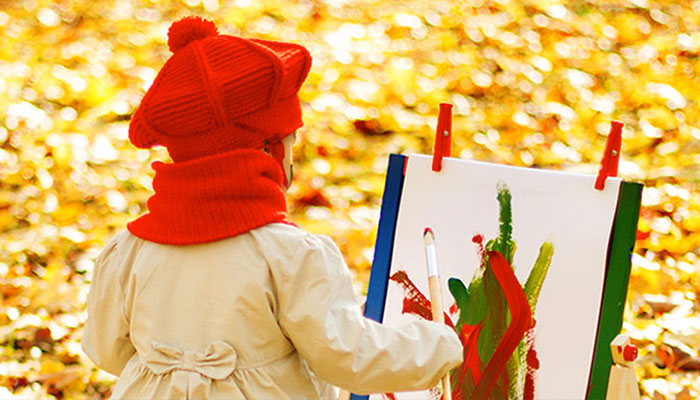While we believe that the books and resources recommended may be of value to you, keep in mind that these are suggestions only and you must do your own due diligence to determine whether the materials are appropriate and suitable for your use. PNC has no sponsorship or endorsement agreement with the authors or publishers of the materials listed.
FALL

Fall Landscapes
Children will discuss and make fall pictures.

Lesson Objective
Children will explore how fall can be visually depicted using color.
(Art) Art
What You'll Need
- Sunny Autumn Day, George Inness; see Cleveland Museum of Art website
- 12" × 18" light blue construction paper – 1 per child
- Brown paper strips – approximately 1"–1½"× 9" – 5 to 8 per child
- Glue sticks – 1 per child
- Yellow, orange, and red tempera paint – 1 bottle each
- Disposable plates – 1 per paint color per table
- Small sponges – 3 per plate
- Corks – 1 per plate
- Newspaper (to cover tables)
What To Do
Note: Prior to the lesson, cover tables with newspaper.
- Show George Inness’s landscape, Sunny Autumn Day. Ask children what colors they see. Discuss how leaves change color in the fall when the temperatures get cooler (see Did You Know?).
- Explain to the children that they will create a fall landscape using paper and paint.
- Demonstrate how to create a forest by gluing brown paper strips to the paper. “Trunks” can stand up straight, tilt, or fall.
- Demonstrate adding fall colors. Show how the paint matches the colors in Inness’s landscape. Apply paint using sponges and corks. Sponges can make leaves; corks can be pumpkins, apples, etc.
- Distribute paper, glue sticks, and several brown paper strips (to create a forest) to each child.
- Place plates of paint in fall colors on the table. Each plate should contain 3 sponges and 1 cork. Encourage children to share, and to keep sponges and corks on the same plate.
- As children work, reinforce vocabulary by discussing their landscapes.
Resources
Home School Resources
Home educators: use these printable lesson PDFs to teach this lesson to your home schoolers. They're available in English and Spanish.
Content Provided By
Common Core State Standards Initiative – These lessons are aligned with the Common Core State Standards ("CCSS"). The CCSS provide a consistent, clear understanding of the concepts and skills children are expected to learn and guide teachers to provide their students with opportunities to gain these important skills and foundational knowledge [1]. (External) Visit the CCSS


